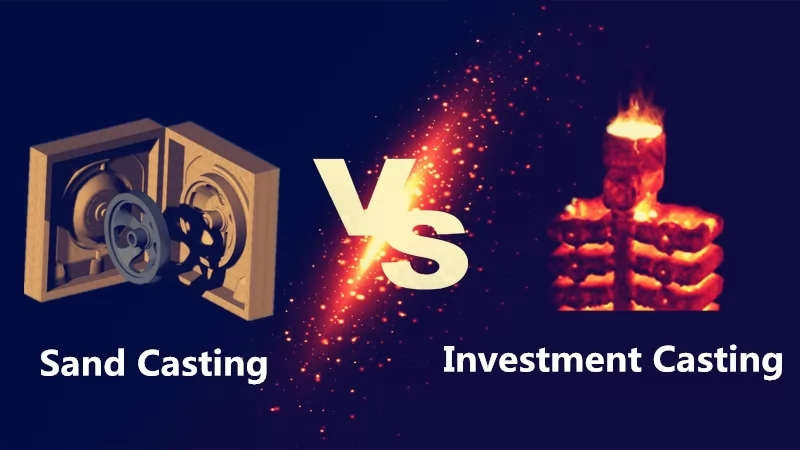Sand Casting Vs Investment Casting
What is Sand Casting Process
In the production preparation process of sand casting, it is necessary to formulate a reasonable casting process plan and draw a casting process diagram.
The casting process drawing is a graphic showing the casting process plan with various process symbols in the parts drawing, including the pouring position of the casting, the parting surface of the casting mold, the number of cores, the shape, the fixing method and the order of the core, and the remaining machining Quantity, draft angle, shrinkage rate, gating system, riser, size and layout of chilled iron, etc. The casting process drawing is the basic process document to guide the design of the model (core box), production preparation, mold manufacturing and casting inspection.
According to the casting process drawing, combined with the selected modeling method, the pattern drawing and the box drawing can be drawn. The enlarged size of the casting for cutting is called the machining allowance. The numerical value of the machining allowance of the casting depends on the production batch of the casting, the type of alloy, the size of the casting, the distance between the processing surface and the reference surface, and the position of the processing surface during casting.
Using machine modeling, the casting precision is high, and the margin can be reduced; the manual modeling error is large, and the margin should be increased. Due to the rough surface of steel castings, the margin should be increased; non-ferrous alloy castings are expensive, and the surface is smooth, and the margin should be smaller than that of cast iron. The larger the size of the casting or the larger the distance between the processing surface and the reference surface, the larger the size error, so the margin should be increased accordingly. During pouring, the surface of the casting facing upward has a higher probability of producing defects, and the remaining amount should be larger than the bottom and side surfaces.

Advantages of Sand Casting
Sand casting molding methods are divided into manual molding and machine molding.
Manual modeling features: convenient and flexible operation, strong adaptability, short preparation time for pattern production, but low productivity, high labor intensity, and difficult to guarantee the quality of castings. It is only suitable for single-piece small batch production.
Machine modeling characteristics: The main method of mass production of sand molds can significantly increase labor productivity, improve working conditions, and improve the dimensional accuracy and surface quality of castings, and reduce the machining allowance.
What is the Investment Casting Process
Investment casting, also known as lost wax casting, includes processes such as pressing wax, repairing wax, assembling trees, dipping slurry, melting wax, casting molten metal, and post-processing.
Lost wax casting is to use wax to make a wax mold of the part to be cast, and then coat the wax mold with mud, which is a mud mold. After the clay mold is dried, put it in hot water to melt the internal wax mold. Take out the clay mold from the melted wax mold and fire it into a pottery mold. Once roasted. Generally, a pouring port is left when making a mud mold, and then molten metal is poured from the pouring port. After cooling, the required parts are made.
Advantages of Investment Casting
The dimensional accuracy of investment castings is relatively high, generally up to CT4-6 (CT10~13 for sand casting and CT5~7 for die casting). Of course, due to the complex process of investment casting, there are many factors that affect the dimensional accuracy of castings, such as molds. The shrinkage of the material, the deformation of the investment mold, the linear change of the shell in the heating and cooling process, the shrinkage of the alloy and the deformation of the casting during the solidification process, so the dimensional accuracy of ordinary investment castings is high, but its Consistency still needs to be improved (the size consistency of castings using medium and high temperature waxes should be improved a lot).
When pressing the investment mold, a pressure type with a high surface finish of the cavity is used, so the surface finish of the investment mold is also relatively high. In addition, the shell is made of a refractory coating made of a special high-temperature resistant adhesive and refractory material, which is coated on the investment mold, and the inner surface of the cavity directly in contact with the molten metal has a high smoothness. Therefore, the surface finish of investment castings is higher than that of general castings, generally reaching Ra.1.6~3.2μm.
The biggest advantage of investment casting is that because investment castings have high dimensional accuracy and surface finish, they can reduce machining work, but leave a little machining allowance on the parts that require higher parts, and even some castings only Leave the grinding and polishing allowance, you can use it without machining. It can be seen that the use of investment casting method can greatly save machine tool equipment and processing man-hours, and greatly save metal raw materials.
Another advantage of the investment casting method is that it can cast complex castings of various alloys, especially high-temperature alloy castings. For example, the blade of a jet engine, its streamlined profile and cooling cavity, can hardly be formed by machining technology. Production with investment casting process can not only achieve mass production, ensure the consistency of castings, but also avoid the stress concentration of residual knife marks after machining.
The Main Difference Between Sand Casting and Investment Casting?
| Sand Casting | Investment Casting | |
|---|---|---|
| Cost | Lower | Expensive |
| Weight | Unlimited | Ozs to 100 lbs. |
| As Cast Finish(RMS) | 150~350 | 60~125 |
| Dimensional Tolerance |
±.010″
±.030″
|
±.010″
±.020″
|
| Casting Alloy | Most black/non-ferrous metals | Most ferrous/non-ferrous metals |






